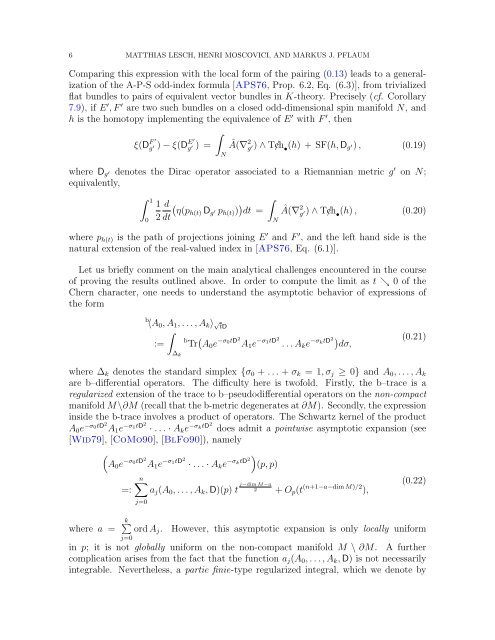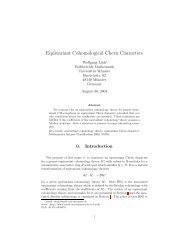Connes-Chern Character for Manifolds with Boundary and ETA ...
Connes-Chern Character for Manifolds with Boundary and ETA ...
Connes-Chern Character for Manifolds with Boundary and ETA ...
You also want an ePaper? Increase the reach of your titles
YUMPU automatically turns print PDFs into web optimized ePapers that Google loves.
6 MATTHIAS LESCH, HENRI MOSCOVICI, AND MARKUS J. PFLAUM<br />
Comparing this expression <strong>with</strong> the local <strong>for</strong>m of the pairing (0.13) leads to a generalization<br />
of the A-P-S odd-index <strong>for</strong>mula [APS76, Prop. 6.2, Eq. (6.3)], from trivialized<br />
flat bundles to pairs of equivalent vector bundles in K-theory. Precisely (cf. Corollary<br />
7.9), if E ′ , F ′ are two such bundles on a closed odd-dimensional spin manifold N, <strong>and</strong><br />
h is the homotopy implementing the equivalence of E ′ <strong>with</strong> F ′ , then<br />
∫<br />
ξ(D F ′<br />
g ) − ′ ξ(DE′ g ) = Â(∇ 2 ′ g ′) ∧ T/ch • (h) + SF(h, D g ′) , (0.19)<br />
N<br />
where D g ′ denotes the Dirac operator associated to a Riemannian metric g ′ on N;<br />
equivalently,<br />
∫ 1<br />
0<br />
1 d (<br />
η(ph(t) D g ′ p h(t) ) ) ∫<br />
dt =<br />
2 dt<br />
N<br />
Â(∇ 2 g ′) ∧ T/ch •(h) , (0.20)<br />
where p h(t) is the path of projections joining E ′ <strong>and</strong> F ′ , <strong>and</strong> the left h<strong>and</strong> side is the<br />
natural extension of the real-valued index in [APS76, Eq. (6.1)].<br />
Let us briefly comment on the main analytical challenges encountered in the course<br />
of proving the results outlined above. In order to compute the limit as t ↘ 0 of the<br />
<strong>Chern</strong> character, one needs to underst<strong>and</strong> the asymptotic behavior of expressions of<br />
the <strong>for</strong>m<br />
b 〈A 0 , A 1 , . . . , A k 〉 √ tD<br />
∫<br />
:=<br />
b Tr ( )<br />
A 0 e −σ 0tD 2 A 1 e −σ 1tD 2 . . . A k e −σ (0.21)<br />
ktD 2 dσ,<br />
∆ k<br />
where ∆ k denotes the st<strong>and</strong>ard simplex {σ 0 + . . . + σ k = 1, σ j ≥ 0} <strong>and</strong> A 0 , . . . , A k<br />
are b–differential operators. The difficulty here is twofold. Firstly, the b–trace is a<br />
regularized extension of the trace to b–pseudodifferential operators on the non-compact<br />
manifold M \∂M (recall that the b-metric degenerates at ∂M). Secondly, the expression<br />
inside the b-trace involves a product of operators. The Schwartz kernel of the product<br />
A 0 e −σ 0tD 2 A 1 e −σ 1tD 2 · . . . · A k e −σ ktD 2<br />
does admit a pointwise asymptotic expansion (see<br />
[Wid79], [CoMo90], [BlFo90]), namely<br />
(<br />
A 0 e −σ 0tD 2 A 1 e −σ 1tD 2 · . . . · A k e −σ ktD 2) (p, p)<br />
n∑<br />
j−dim M−a<br />
(0.22)<br />
=: a j (A 0 , . . . , A k , D)(p) t 2 + O p (t (n+1−a−dim M)/2 ),<br />
where a =<br />
k ∑<br />
j=0<br />
j=0<br />
ord A j .<br />
However, this asymptotic expansion is only locally uni<strong>for</strong>m<br />
in p; it is not globally uni<strong>for</strong>m on the non-compact manifold M \ ∂M. A further<br />
complication arises from the fact that the function a j (A 0 , . . . , A k , D) is not necessarily<br />
integrable. Nevertheless, a partie finie-type regularized integral, which we denote by

















